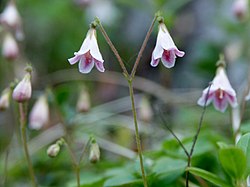

A subshrub (Latin suffrutex), undershrub, or shrublet [1] is either a small shrub (e.g. prostrate shrubs) or a perennial that is largely herbaceous but slightly woody at the base (e.g. garden pink and florist's chrysanthemum). [2] The term is often interchangeable with "bush". [3]
Contents
Because the criteria are matters of degree (typically height) rather than kind, the definition of a subshrub is not sharply distinguishable from that of a shrub; examples of reasons for describing plants as subshrubs include ground-hugging stems or a low growth habit. Subshrubs may be largely herbaceous, although still classified as woody, with overwintering perennial woody growth that is much lower-growing than the deciduous summer growth. Some plants described as subshrubs are only weakly woody, and some persist for only a few years at most. Others, such as Oldenburgia paradoxa , live indefinitely (though they are still vulnerable to external effects), rooted in rocky cracks.
Small, low shrubs such as lavender, periwinkle, and thyme, and many shrub-like members of the family Ericaceae, such as cranberries and small species of Erica , are often classed as subshrubs.